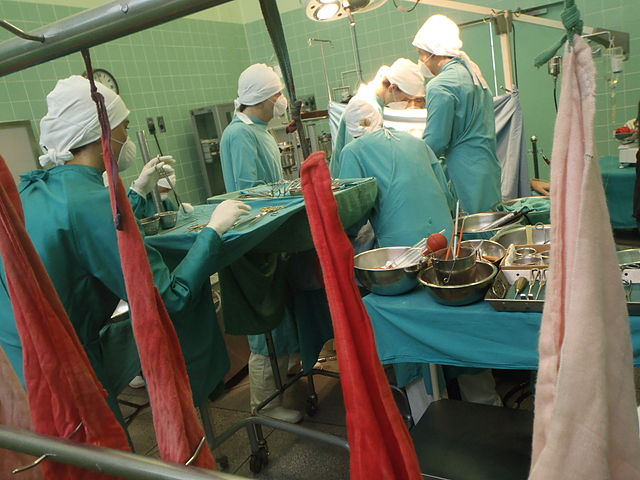
Why are organ transplants so difficult? Because the organs are usually harvested from people who have died, there is a very short time window to perform the transplant, and the immune system tries to destroy the new organ.
There are very few organs that can be taken from a living donor. You can obviously take blood, bone marrow, and skin from a living donor because they regrow themselves. You can take one kidney, one lung, up to 60% of a liver, part of a pancreas, and part of an intestine. You can live with only one kidney and one lung. The liver will regenerate itself. The rest of the organs are necessary to sustain life and can only be donated after death. It is possible to take the kidneys, liver, lungs, heart, pancreas, intestines, eyes, hands, face, bones, skin, veins, parts of the heart, ligaments, and tendons. It is said that one dead person can save the lives of eight other people. It is great to know that you can save someone when you have died, but it cannot be easy for the family of the victim or the recipient.
There is a relatively short period of time to perform the transplant because the organs start to shut down and decompose. The organ needs to be prepared as soon after the person has died as possible because the body will start to decompose itself. Often, the donor victim, although technically dead, will be kept “alive” on life support to make sure that decomposition doesn’t start. Before the organs are removed, all of the blood is flushed out of them and is replaced with an ice-cold solution that contains electrolytes and nutrients. This is partly because the blood type might not be a match with the new donor, but also to slow down the decomposition and preserve the organ. The organs are packed in wet ice in sterile containers and transported to the organ recipient. Different organs can survive for different lengths of time after removal. Hearts and lungs can last 4 hours. Intestines can last 8 hours. A pancreas can last 8 to 12 hours. Livers can last 12 to 18 hours. Kidneys can last 24 to 48 hours.
The biggest problem, though, with organ transplantation is rejection by the recipient’s body. We all have an immune system that works to protect us from foreign organisms entering our bodies and causing damage. To do this, the lymphocytes, which are a type of white blood cell, look for antigens, which are proteins that coat the surface of every organism. The lymphocytes have a database of all of the antigens they recognize, and any antigen that is not in the database gets attacked. This is how the immune system knows how to go after viruses and why it doesn’t attack cancerous growths.
When an organ is transplanted, the antigens that are attached to its cells will be the antigens from the donor and not the recipient. The recipient’s immune system will not recognize them and it will attack them, trying to kill the cells and get them out of the body. The immune system is just doing what it is supposed to, but in this case, we don’t want it to. This can happen instantly, in which case the organ needs to be removed so the recipient doesn’t die. It can happen a week after, up to 3 months, and the organ has to be removed. It can happen over many years where the body slowly destroys the new organ, meaning it will stop working.
There are three ways to prevent this. The first way is to take an organ from a donor that has the same antigens. Before a transplant is attempted, the hospital tries to get as close a match as possible to reduce rejection. If you are genetically related to the donor, there is a chance you will share the same antigens and these transplants are the most effective. However, only identical twins actually have exactly the same antigens.
The second way is to take immunosuppressant drugs. These are drugs that stop the immune system response. This means the person won’t reject the new organ, but it means that their immune system no longer works as well. This is a fine balance because doctors need the new organ to be accepted, but if they shut down the person’s immune system completely, they will be defenseless against colds and any kind of infection, which can be very dangerous.
The third way, and something which is not possible yet, is to 3D print an organ using stem cells harvested from the recipient’s own body. This has the most promise because the antigens would be identical and there would be no rejection. Last year, a woman in the USA received an ear made of cartilage taken from her body and made on a 3D printer. However, it is a long way from making a piece of cartilage that doesn’t have to move to an organ that needs to do a whole host of jobs and be connected to nerves. Experts believe it may be possible to 3D print organs in 10 to 20 years. And this is what I learned today.
Sources
https://fortune.com/well/2023/02/15/3d-printed-organs-may-soon-be-a-reality/
https://my.clevelandclinic.org/health/drugs/10418-immunosuppressants
https://www.ncbi.nlm.nih.gov/books/NBK10770/
https://www.nyp.org/transplant/organ-donation/organ-transplant-process
https://www.organdonor.gov/learn/what-can-be-donated
https://www.medicalnewstoday.com/articles/325631#statistics
https://medlineplus.gov/ency/article/000815.htm
https://www.betterhealth.vic.gov.au/health/conditionsandtreatments/organ-and-tissue-transplantation
https://en.wikipedia.org/wiki/Organ_transplantation
